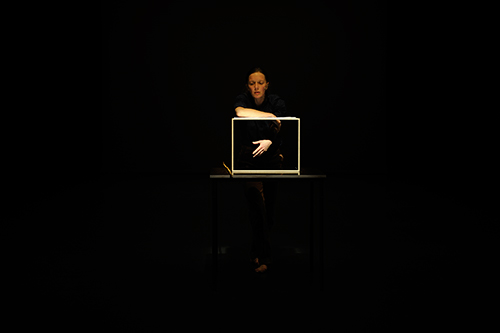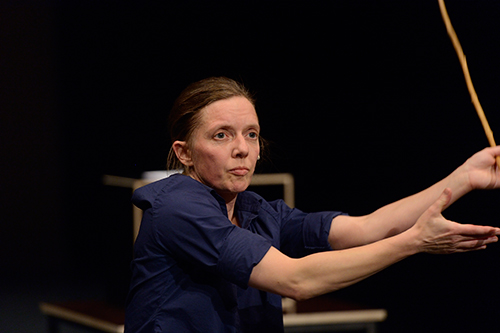Das Licht lenkt allmählich die Aufmerksamkeit von der Publikumstribüne in den Bühnenraum. In dessen Mitte steht ein einfacher Tisch, darauf ein Holzkasten ohne Boden, derart auf eine Seite gekippt, dass man durch ihn hindurchsehen kann. Das Bühnenende ist durch eine weiße Projektionsfläche markiert. Auf dem Holzkasten liegt ein Stapel beschriebener Blätter, sorgfältig zurechtgelegt.
Read more
Bereits der Programmtext des Dramaturgen Saša Božić kündigt eine Fusion aus verschiedensten Vortrags- und Darbietungstechniken an, angesiedelt zwischen autobiografischen Einblicken und musiktheoretischer Reflexion über die Kompositionsprinzipien einer barocken Fuge. Eine ambitionierte Polyphonie von Musik und Bewegung, Form und Inhalt, Innen und Außen, Verstehen und Sehen und schließlich dem auf der Bühne unweigerlich entstehenden Paradox zwischen der Person Isabelle Schad und der Darstellerin Isabelle Schad. Über allem zeigt sich die Einsicht in die stetige Konstruktion von Welt, des Ichs, mittels unumgehbarer Systeme, Disziplin und Codes, innerhalb derer im Grunde alles zur Darstellung wird. „Fugen“ ist eine komplexe Arbeit, die sowohl die Choreografin Isabelle Schad auf bisher ungesehene Art und Weise herausfordert als auch ihr Publikum. Dieses wird an die Grenzen seiner Auffassungsgabe geführt. Zugleich schafft das Stück jedoch die Möglichkeit über jene Grenzen hinwegzugehen, in der sich zeitweilig einstellenden Einheit von Sehen und Hören, von Intellekt und Ästhetik.
In blauer Bluse und beiger Hose betritt Isabelle Schad die Bühne. Die Haare exakt zurückgebunden. Ein überraschender Anblick, überschritten in vergangenen Soloproduktionen doch übergroße Kostüme und schließlich der nackte Körper, verlängert durch meterlange Stoffbahnen, die Grenzen von Körper und Umgebung. In „Fugen“ dagegen changiert Isabelle Schad zwischen der Rolle der Vortragenden, der Darstellerin und ihrer selbst. Ihre Arme beginnen um den Körper zu schwingen, dieser dreht sich kontinuierlich, in seiner Dynamik an- und abschwellend. Fast scheint es als vollziehen ihre Bewegungen Phrasen, beschreiben einen Beginn, eine Maxime und schließlich ein Ende. Ein leises Summen begleitet ihre Drehungen, die zeitweilig den gesamten Bühnenraum umfassen. Im Zentrum des hinteren Bühnenendes kommt sie allmählich zum Stehen, ihr Körper schwingt noch eine Weile nach. Jener Moment schafft in der eigenen Aufmerksamkeit eine unsagbare Sogwirkung erfüllt von Präsenz. Spätestens mit dem anschließenden Verweis von Isabelle Schad gerade ihre eigene Produktion „Ohne Worte“ von 2009 zitiert zu haben, schichtet sich die Erfahrung einer vergangenen Präsenz darüber.
Einen Kontrapunkt ganz anderer Art setzt die Szene, in der die Choreografin einen Bambusstab kontinuierlich um das rechte und dann wieder das linke Handgelenk schwingt, den Rhythmus der erklingenden „Matthäuspassion“ von Johann Sebastian Bach verfolgend. Exaktheit und Zählen treffen hier auf das freie Spiel des Bambusstabs. Weit zurückliegende Kindheitserinnerungen und die Lust sich zur Musik zu bewegen vermengen sich mit Isabelle Schads heutigem Körper, der durch klassisches Ballett, zeitgenössischen Tanz, Techniken des Body-Mind Centering sowie ostasiatischer Körperpraxen wie Aikido und Shiatsu geprägt ist. Schnell erschöpften sich für sie die Bilder des klassischen Balletts und es folgte die Verweigerung der Auswahl nach Größe und Körper, der Hierarchie eines Ballettensembles und der vielbeschworenen Schönheit der Linie. Beschrieben werden kann ihr Weg, dessen Spuren „Fugen“ nachverfolgt, als die kontinuierliche Suche nach anderen Arbeitspraktiken, horizontal organisierten Kollaborationen und Körpertechniken, die das Material des Körpers, seine Knochen, sein Fleisch, seine Organe und auf mikroskopischer Ebene seine Zellen ins Zentrum rücken und schließlich zur Suche nach individueller Kollektivität auf der Bühne führen. Ein polyphoner Weg, der in „Fugen“ erstmals derart sichtbar, die Arbeit, die Übung, das Training einer solchen Suche auf die Bühne bringt und immer wieder zum Anfang zurückkehrt: Johann Sebastian Bach und die Lust aus Kindertagen sich zur Musik zu bewegen. Die Erfordernisse dieses kontinuierlichen Trainings machen jene Momente berührend erfahrbar, in denen sie die Exaktheit zur Bewegung zu sprechen, zur Musik sich zu bewegen für einen Moment verfehlt und das Zählen bzw. die Wiederholung die Illusion des Theaters an die Oberfläche bringt.
„Fugen“ stellt eine von Isabelle Schads persönlichsten Arbeiten dar, die zugleich auch die Zweifel der Choreografin auf die Bühne bringt: Wie lange wird sie wohl das Bedürfnis haben zu produzieren, um im und mit dem Theater eins werden zu wollen? Muss ihre Suche nach einer anderen, individuellen Form der Kollektivität wohl eine Utopie bleiben? Jene Fragen schwingen nach, am Ende, im Dunkel des Theaterraums, zum Klang des durch die Luft geführten Bambusstabs.
Veröffentlicht am 31.10.2015, von Maria Katharina Schmidt
Fugen
Vendredi 27 Novembre
Isabelle Schad est une artiste qui m’a touché par sa sincérité et son naturel. Je me rappelle distinctement là façon dont elle nous a regardé nous spectateur, un par un, d’une façon très… humaine. D’habitude, les danseurs suivent une ligne de conduite qui leur enlève cette humanité.
C’était comme si elle nous regardait pour se préparer. Je pense qu’elle a besoin d’identifier son public avant de jouer pour lui. Elle n’eut de pudeur ni dans le regard, ni dans ses paroles. La chorégraphe nous dévoila des fragments de son existence qui l’avaient amenée jusqu’ici, devant nous.
Mais elle commença par exécuter une dance très dynamique et tourbillonnante. Son corps devenait incroyablement performant et précis, ses bras pénétraient l’air avec vitesse pendant qu’elle se déplaçait sur toute la surface de la scène.
J’ai trouvé très intéressant son rapport aux arts martiaux et la façon dont ils l’influençaient dans ses mouvements. J’ai particulièrement apprécié son aisance lorsqu’elle manipulait un bâton en bois grand d’environ deux mètres. Elle le faisait tourner très rapidement avec un geste qui évoluait pendant qu’elle nous parlait de son rôle de révélateur, d’amplificateur du mouvement.
En effet, son spectacle mêlait le geste à la théorie. Parfois elle parlait en dansant, parfois elle lisait et parfois ses pas étaient guidés par une conversation retransmise.
Celle qui parlait de la fugue m’a beaucoup plu.
La fugue est une construction musicale qui joue sur la répétition et la variation du sujet répété.
Ce qui m’a frappé c’est le fait que ce principe se retrouve dans l’art à travers certaines séries d’œuvres. Un exemple très récent et local, sont les séries de Claire Colin-Collin qui expose à partir de Janvier à l’H du siège de Valenciennes. Dans une conférence qui a eu lieu à l’ESAD, elle nous parlait de son processus de travail qui consiste à répéter un geste, le décliner et parfois exploiter l’accident.
La représentation d’Isabelle Schad était en bref très enrichissante, elle m’a donné envie d’en apprendre plus sur le système et la construction de la fugue. Peut être que pour un public qui n’est pas initié à l’art, ce spectacle aurait pu être difficile à comprendre. Mais la beauté de sa chorégraphie ne nécessite pas de réflexion approfondie pour être appréciée.
Rémi Mahieux
With the fugue as a metaphor
Isabelle Schad examines the fugues’ spirit in her work.
There has not been a week since the premiere in Berlin when Isabelle Schad is part of our annual festival with her solo Fugen. As part of a carefully thought out concept Schad moves between the genres of performance, lecture, and dance. Her own development as a dancer, coming from the classical and contemporary dance and the new perspective which integrates cognitive and bodily approach within the Body-Mind Centering, further to the depths of Asian forms such as Aikido and Shiatsu, runs like a thread through the performance. The resonance and the collective embodied insights, provide both depth and value, offering reflection on a level of very precise and detailed body expression.
There is a podium on stage with a printed lecture, a screen that could be used for projection, some speakers and a stick. Isabelle Schad comes in, measures the audience with her eyes and begins with a circling dance that goes towards more sweeping shapes. When she finishes, she says that it was an excerpt from a previous performance, Ohne Worte from 2009.
With her childhood emotional experiences of dance and new insights of dance discipline in ballet as a springboard, Schad enters the theme -the fugue as a metaphor for the dancing body and her dance which is what the title indicates. Supported by a pre-recorded conversation with a musicologist who sorts out different aspects, the materiality and nature of the fugue, she starts to develop the theme further in her physical preparation with and without the stick, with or without speech, always with an impressive control of energy and entity.
The thought behind the concept appears as crystal clear, reasoned and insightful as the physical expression. One follows the performance with unbroken and growing interest – the reasoning behind then and now, the materiality and fixed-term nature of the conceptual as well as the physical dimension.
Hufvudstadsbladet, Jan-Peter Kaiku 5/11/2015
Mit der Fuge als Metapher
Isabelle Schad untersucht den Geist der Fugen in ihrer Arbeit
Noch nicht einmal eine Woche seit der Premiere in Berlin ist es her, daß Isabelle Schad ihr neues Solo Fugen in unserem jährlichen Festival in Helsinki zeigt. Als Teil eines klug durchdachten Konzepts, bewegt sich Schad zwischen den Genres, zwischen Performance, Lecture und Tanz. Ihre eigene Entwicklung als Tänzerin, die sich vom klassischen zum zeitgenössischen Tanz erstreckt, und die neuen Perspektiven, welche geistige und körperliche Ebenen zusammenbringen innerhalb von Body-Mind Centering, bis hin zu den tiefen Erkenntnissen asiatischer Formen wie Aikido oder Shiatsu, ziehen sich wie ein roter Faden durch die Performance. Die Resonanz und verkörperten Einsichten bieten sowohl Tiefe als auch Wert(volles): Reflexion auf einem sehr hohen Niveau von Präzision und detaillierten Körperausdruck.
Auf der Bühne gibt es eine Art Podium mit ausgedruckter Lecture, eine Leinwand, die für Projektionen genutzt werden könnte, einige Lautsprecher und ein Stock. Isabelle Schad kommt herein, mißt das Publikum mit ihren Augen aus und beginnt mit einem kreisenden Tanz, der zunehmend zu peitschenden Formen übergeht. Wenn sie damit fertig ist, sagt sie, daß dies ein Auszug aus einer älteren Performance ’Ohne Worte’ aus 2009 war.
Mit ihren emotionalen Erfahrungen in Tanz aus ihrer Kindheit und neueren Erkenntnissen über das Verhältnis von Tanz und Disziplin im Ballett als Ausgangspunkt, beginnt Schad mit dem Thema: Die Fuge als Metapher für den tanzenden Körper und für ihren Tanz, wie es der Titel suggeriert. Unterstützt durch ein aufgenommenes Gespräch mit einem Musikologen, der verschiedene Aspekte, Materialitäten und die Natur der Fuge beleuchtet, führt sie das Thema weiter in ihrer physischen Verarbeitung, mit oder ohne Stock, mit oder ohne Text, jedoch immer mit einer beeindruckenden Kontrolle über Energie, Körperlichkeit und Präsenz.
Der Gedanke hinter dem Konzept erscheint so kristallklar, klug und aufschlussreich wie der physische Ausdruck.
Man folgt der Performance mit wachsendem Interesse – dem dahinterstehenden Nachdenken, dem Hier und Dort, der Materialität, sowie der kurzweiligen Natur der konzeptuellen wie der physischen Dimension.
Hufvudstadsbladet, Jan-Peter Kaiku 5/11/2015











 With Fugues, Berlin choreographer and dancer Isabelle Schad continues her work between musical concepts and their expression in movement. Coming from a music background and a lifelong interest in the polyphonic work of J.S. Bach, she attempts to look at her own (hi)story and the origins of (her) movement between discipline and pleasure. Fugues is an autobiographical work in which the performer’s body serves as an example for the construction of the individual within disciplines and systems one cannot escape from.
With Fugues, Berlin choreographer and dancer Isabelle Schad continues her work between musical concepts and their expression in movement. Coming from a music background and a lifelong interest in the polyphonic work of J.S. Bach, she attempts to look at her own (hi)story and the origins of (her) movement between discipline and pleasure. Fugues is an autobiographical work in which the performer’s body serves as an example for the construction of the individual within disciplines and systems one cannot escape from.
